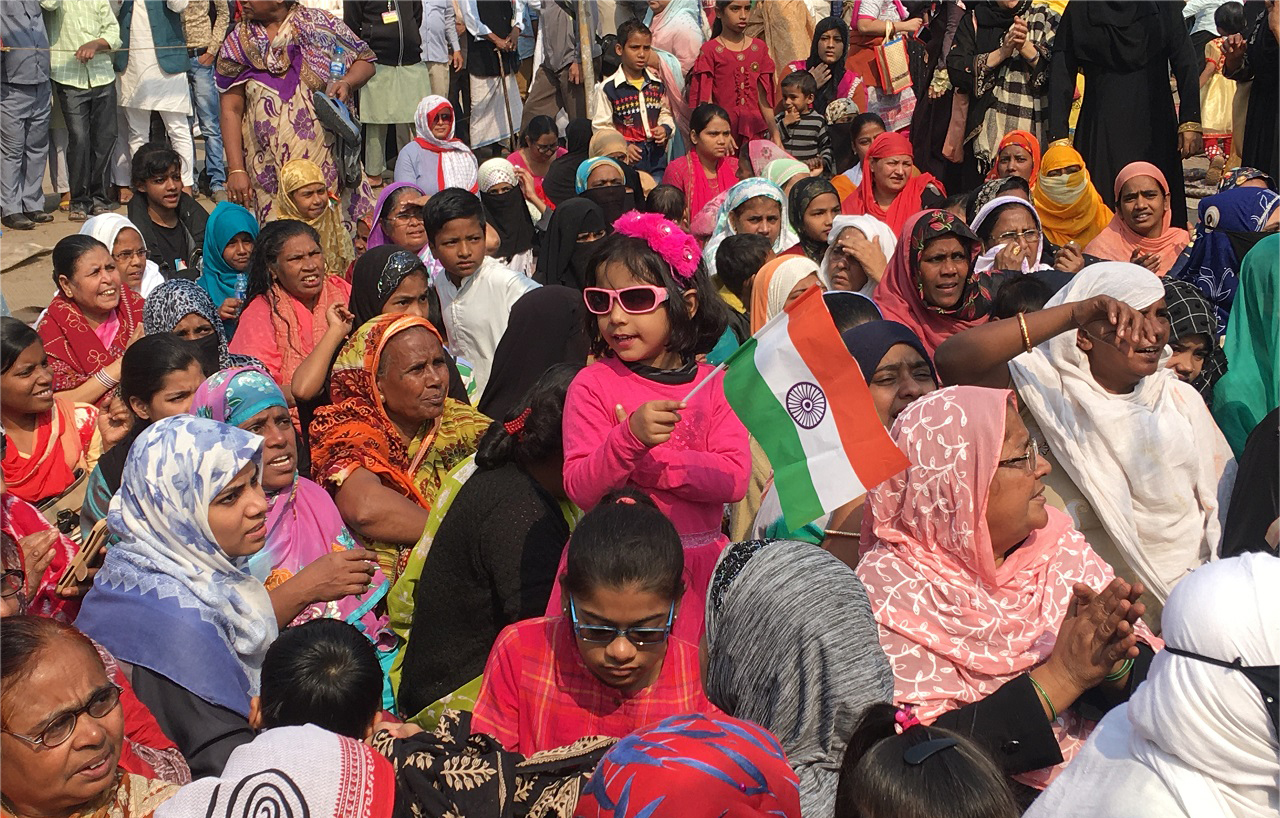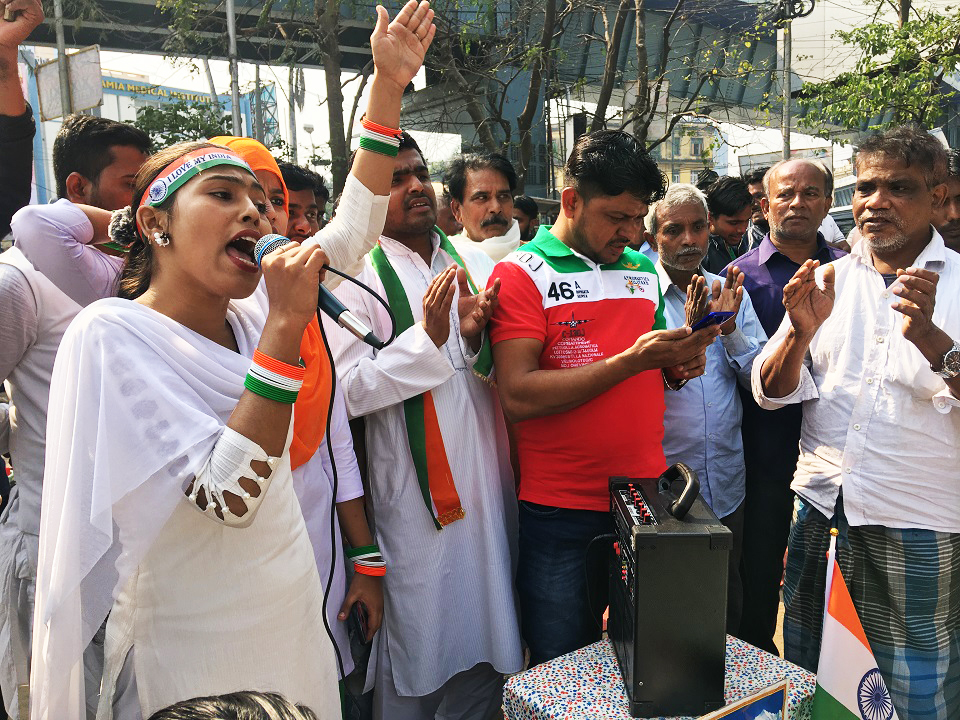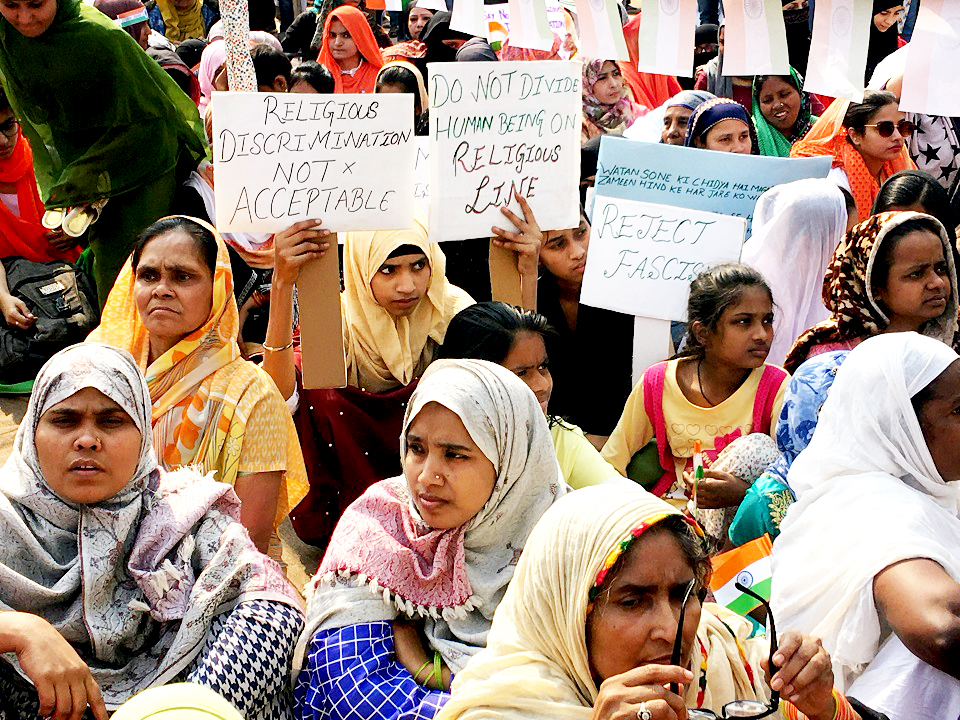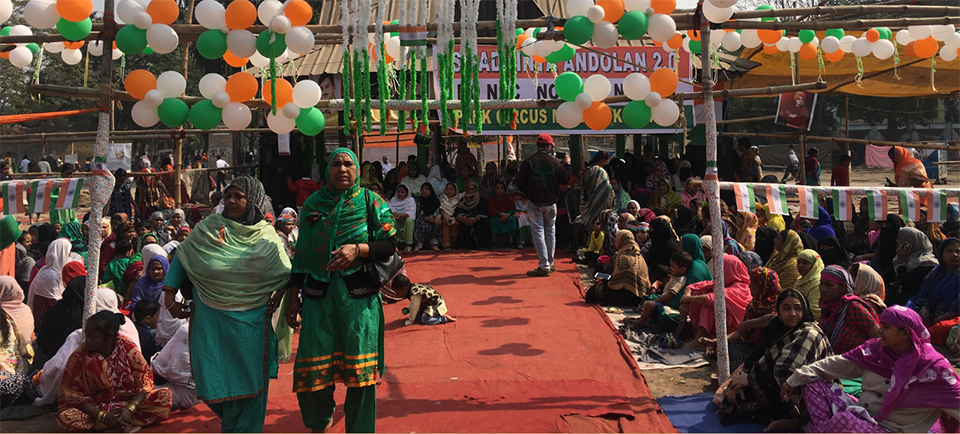Last Saturday, Sameeda Khatoon, 57, breathed her last after a cardiac arrest at the Park Circus protest site. Sameeda was one among the thousands of “nameless” women, who are in a continuous sit-in at Park Circus Maidan in Kolkata, demanding repeal of the Citizenship Amendment Act (CAA). She came and sat there almost every day, braving falling health and the bitter cold. Sameeda will be remembered as one of the martyrs of the anti-CAA movement in India. This report by Nandini Dhar is a tribute to Sameeda and the other women like her, who are leading the resistance against the present fascist regime at Park Circus.
1.
“Agar Modi yeh saab chhabis tak wapas le letein, toh achha hota na? Kyunki chhabis hamara sangbidhan dibas hain” (If Modi had taken all of this back by 26th, it would have been nice, no? Because, 26th is our Constitution Day), this was what Nafissa Begum had said to me on 19 January. Nafissa looks slightly past middle-age – anywhere between 55 to 60 years – and like a lot of the women whom I met there, comes to the Park Circus protest in Kolkata everyday with her bhabi and daughter. While her daughter works around the protest stage, Nafissa and her sister-in-law Yasmin sit in the designated area for women. “Aap to daily passenger ho (You are a daily passenger),” Nafissa says, putting her arm around me. “Daily passenger” is a term that the women here often use to refer to women like myself, who are not from the neighbourhood or the community, yet who drop by often at the protest venue.
Predominantly Hindu, predominantly secular, predominantly upper middle-class, predominantly over-educated, the “daily passengers” could have lived their entire lives in Kolkata without ever stepping into a neighbourhood like Park Circus. Save and except for a biriyani-meal in one of the eateries that line almost all ends of the side-walks in the area. In other words, Park Circus has existed in the city’s middle-class, Hindu imaginary primarily as a “ghetto,” and that too, a Muslim ghetto. Liberal Hindu Bengalis often drop by such ghettoes for a meal of biriyani and kabab, wax romantic about them, yet their relationship with people whose everyday lives and cultures have produced such cuisines, remain cursory at best. In lots of ways, the patterns of Hindu liberal patronage of the Park Circus restaurants can be a test case for the ways in which Muslim cuisine is exoticized within the mainstream Bengali-Hindu culture, even as Muslims themselves continue to be considered as cultural “others.” But, that’s a story for another day. The truth is, ethnic “ghettoes” rarely exist in our dominant cultural and psychological worlds beyond stereotypes and such stereotypes in turn create a sense of eerie unfamiliarity. The truth is also that, prior to this protest, most of us — the left-liberal, progressive bunch in the city — have not quite imagined Park Circus as a central locus of political activity against the mighty Indian state.
But, in a very significant way, the specific form of Muslim women-led protests we have witnessed in India ever since the women at Shaheen Bagh in Delhi had sat down blocking one of the major highways in the Delhi-NCR region, has also forced us to do an important political work of spatial reconstruction. Spaces and places that would have otherwise remained outside of our privileged, upper middle-class, left-liberal cartographic imagination – Shaheen Bagh, Park Circus, Ghantaghar, SabziBagh – have made their existences known. Not only that they have made their existences known and felt, they have also marked themselves as centers of unique forms of protests. In most of these protests, Muslim women – often from working-class or lower middle-class families — have occupied and sat down in a somewhat prominent public space or square, often accompanied by their families, and have politely declared that they are not going to move until the CAA, NRC and NPR have been revoked.
In some ways, the mode in these protests is utterly non-confrontational. Although militant, angry slogans are often shouted at and performed from the open stage, almost all of the guests, including the police, are dealt with utmost hospitality, warmth and humility. There have been attempts on the part of the state to thrust a certain kind of confrontations upon the protesting women. At Lucknow, for example, the police had been seen confiscating blankets and food items from the protesting women. At Park Circus, on January 8, 2020, on the first day of the assembly, the police had asked the women to go back. Permission to set up tents and makeshift arrangements for drinking water didn’t come until a few days later. The women have responded by assuming the burden of such affronts often with a kind of stoic dignity and determination.
For example, at Park Circus, even during the coldest of the January nights, the women have stayed put. And, anyone visiting them would know, they have done that without much aplomb. If women have often been read and described as “hysterical” by both the state (remember the time when the protesting women at Kashmir had been described as hysterical?) and society, the quiet dignity of the women at Park Circus and elsewhere, have turned the very discourse of “female hysteria” on its head. If one goes by the recent actions of the Modi-Shah contingent, hysteria is a term that one needs to apply to the fascist state and the kind of masculinity upon which it is predicated.
2.
While a young man announces from the microphone on stage, “Aapka saaman aur aapka bachha aap hi ka zimedaari hain” (you alone are responsible for your belongings and your children), in between the speeches, Nafissa and Yasmin take the time to chalk out a plan for the housework for the next day. They live together and Nafissa’s brother had died more than 25 years back. Yasmin earns her livelihood by providing Arabic tuitions. Nafissa is a housewife. Her husband owns a small cigarette shop in the Dharmatala area. Mostly, they come around 11 am, and stay till midnight, sometimes making quick trips back home to take care of the work there. Mostly, they take turns to go back and do whatever needs to be done to take care of the cooking and cleaning at home.
“Bohot mehnet hote hain na?” ( It’s a lot of work, no?), I ask them. Yasmin nods in assent, “wohi toh” (that’s what), and then adds, “auroton ka kaam kabhi khatam nahi hote” (women’s work is never done), and laughs. “Lekin haq ke liye to mehnat karna hi parega. Yeh humara haq ka baat hain” (But, in order to earn one’s rights, one needs to work hard. And this is a question of our rights), Nafissa says.
“Jisko ghar-parivar chalana nahi aata hain, woh kaise desh chalaye ga?” (The one who can’t even run his own family, how can he run an entire nation?), Yasmin says, referring to Narendra Modi, the Prime Minister. “Is liye to unho ne auroton ko ghar sein nikal ke sarak par le aaya” (this is why he has dragged the women out of their homes into the streets), Nafissa comments. She puts her hand against mine. “Jo khun mera sharer mein hain, woh aapka sharer mein hi hain. Lekin yeh baat Modi ko samajh mein nahi aata hain” (the blood that flows through my body, flows through yours too. But, Modi has no understanding of it), she says.
Nafissa had been to protests before. Sometimes for the “laal party”, sometimes for TMC. “Lekin un sab sein yeh alag hain” (but this is different from all of that), she says. “Yeh to hamara aapna baat hain na” (This is about ourselves and our rights). There are certain metaphors and images through which a lot of the women at Park Circus explain the current protests. One of them happens to be the way in which the current regime has “dragged” women out into the streets.
Take for instance the case of Areeba and Afreen. Both of them are first year students at Aaliyah University. When I first saw them, they were chanting azadi slogans – right outside the designated protest area – along with two other young women. They were chanting and raising their fists up in the air as if they were in a trace. And, if there is anything that these protests have accomplished within the contemporary histories of protests in India, it is precisely this. They have shown to an entire generation of Indian citizens, who have otherwise grown up within the post-liberalization calm, that chanting slogans can be an art-form on its own right.
In fact, there are many break-out groups throughout the protest venue, like Areeba and Afreen’s, who chant slogans, sometimes walk around in circles around the main protest arena, shaking in the air the Indian national flag and other signs. It would not be an exaggeration to say that during the evenings, the venue does begin to feel like a carnival.
Areeba and Afreen have attended their first protests on December 19, 2019 – the day a nationwide protest was organized against the CAA, NRC and NPR. They had been coming to the anti-NRC/CAA protests ever since. Sometimes, they bring their mothers along with them. “For us, Park Circus is a continuation of December 19,” Areeba says. “We feel very safe here,” Afreen adds, “we feel very safe here. It is a protest organized by women. So, we feel very comfortable expressing ourselves in this venue.”
“Modi government is shameless,” Areeba says, “The fact that we, girls, are in the streets, should have shamed him. But, it doesn’t.” Afreen joins her, “We are students. We should have been in college. We should have been at home. We should have utilized this time studying.” Areeba and Afreen’s lives are different from Nafissa and Yasmin’s in many ways. Yet, when they describe their own participation within the anti-CAA movement, their metaphors are somewhat similar. In very specific ways, then, the movement has succeeded to create a reservoir of images and metaphors, for the participants to use, recycle, re-create and modify.
It would be dishonest to say that I see women’s place in the world exactly in the same way Nafissa, Yasmin, Areeba or Afreen do. I do not, for instance, think there is any normalized and naturalized association between home – the domestic space – and women. I do not think, for example, that there is any “shame” in girls and women protesting out in the streets (or elsewhere). When I speak about space and gender, I demand women’s access to public spaces. I problematize the very notion of home as the primary locus of women’s social lives and identity. I celebrate women’s stepping out and contributing to the public sphere, complex and contradictory as it often is, and can be. In very precise ways, then, the categories through which many of the participants theorize their own presence in the movement, put pressures on mine. Yet, there is a way in which this very rhetoric, built upon a dichotomy between the “home” and the “street,” from which I admittedly feel a distance, succeed to take hold of the Hindu Rashtra by its throat. And, it does so through the categories espoused by the Hindu Rashtra itself.
3.
At the heart of the anti-CAA struggle, is a struggle of ownership over space. The space that one calls home. The place where one lives. The place that happens to be a material space. The space that one calls one’s “nation,” “watan,” “hind”, “desh”, also happens to be a material place. A material space that often doubles up as a symbolic place, and grants one one’s rights. It is the possession of these rights that makes one a citizen. The word “home” becomes the word that expresses all of these and more. The “home”, for better or for worse, has become one of the key political categories of the anti-CAA struggle.
Take for example Sakina Begum, who happens to be a Bengali Muslim from the Topsia area. She herself comes every day, and often brings her relatives and children along with her. Sakina works as a domestic help. This is the first time that she has ever joined a protest.
“Keno eshechhen?” (Why are you here?)
“Keno abar? Oi NRC.” (That NRC. What else?)
“Kemon lagchhe?” (How do you feel?)
“Bhalo to. Koto lok.” (Good. Lots of people.)
“Kaal abar ashben?” (Will you come here again tomorrow?)
“Aashbona? E ki mela naki go, je ekdin eshe aar tarpor ashbuni? Jotodin daabi na mete, ashbo.” (Why shouldn’t I come? Is this a fair that I will just show up for a day and then stop coming? Until our demand is met, I will come.)
“Aar bachhader schooler pora? Homework? Roj bikele ele oder porar kshoti hobe na? (And what about your children’s homework? Wouldn’t it hamper their studies if you continue to come here every evening?)
“Ghar nathakle abar school ki go?” (what is school when your home is gone?)
There is an understanding of citizenship inherent in Sakina’s words, expressed in the word “ghar” – home. A word that connotes both a material-physical space and an abstract notion of belonging. It is against such notions of “home” or “ghar” that the Hindu Rashtra’s demands for documents stand . The documents — the “kagaz” – the absence of which will take away one’s citizenship and will ultimately land one in a detention center.
The “kagaz”, here, then, too functions both as a material object and an abstract referent, elevated to a political category, just like home, conjoined as it is by two spaces – the “home” and the detention camp. In very simple terms, then, the anti-CAA struggle is about the right to stay put. The right to stay put, hold on to one’s home and not end up in the detention camp.
In fact, the spectre of the detention camp exists in the women’s casual expressions, and has, often times,been turned into an object of humour. “Kambal nahi hain to kya hua? Detention camp ke liye thoda practice to ho raha hain” (What if there are no blankets? At least we are getting some practice for the detention camps), “Abhi bhi jagne ke liye taiar nahi ho to detention camps mein sona padega” (If you are still not prepared to stay awake, you will have to sleep in the detention camps). The assembly on the street, therefore, becomes a form of symbolic civil and political action. A symbol of staying put, a symbol of holding onto one’s own place and space. The “public” streets, then, become the “private” home through the protests, and it is by staying put in the former that the women are stating their claims for the latter. In the process, the very notion of home becomes somewhat publicized and, of course, politicized.
The “ideal” woman, for the Hindu Rashtra, is the one who stays at home. In thus identifying the domestic space as the naturalized space for women, the Hindu Rashtra is not exceptional. In making that claim, it comes to embody the gender politics of other fascist states. There is then a strange twist in framing the popular rhetoric of the movement in familial terms. The movement, in very crucial ways, flips the very rhetoric of the domestic ideology of the Hindu Rashtra around.
In the persistent use of the metaphor of the current regime “dragging” the women out into the streets, the women show that the Hindu Rashtra does not, after all, respect its own idealized vision of women inside the homes. All women are not supposed to stay inside their homes after all. Just in the same way some lives are more important for the Hindu Rashtra, some homes are more valuable than others. The Muslim homes, just like the Muslim lives, can be devalued, disrespected, snatched away through the sheer use of state documents – the ever-present shadow of the “kagaz” which frames much of the rhetoric of the movement. And, in snatching away the Muslim home, the Hindu Rashtra makes it impossible for Muslim women to embody the idealized version of the state’s domestic ideology. It is, therefore, in this imagery of the Muslim women being “dragged” out into the streets, that the Hindutva’s essential politics of dehumanization of Muslim lives lies.
4.
I meet Nafissa again on January 26th, right after I came back into the designated area for women, after joining the Human Chain, “Dekha, Modi ke liye deshka sangbidhan kabhi kuch samman nahi hain. Agar hote to aaj yeh NRC wapas le lete. Upar se to court use chaar hapta ka time de diya.” (See, Modi has no respect even for the nation’s constitution? If he did respect the Constitution, he would have revoked the NRC. Now, on top of it, the court has given them four weeks more. They think, if they have more time, the people will simply flee. But, they have no idea what women’s power looks like). Yasmin lightly touched me on the arm, “Chalo, ekkaam to Modi ne kiya. NRC to aap jaise logon ko humare mahalle mein lein aya” (Modi has done one thing. This NRC has at least brought people like you onto our neighbourhoods).
The truth is, for the rest of the city, the neighbourhoods that are often identified as overwhelmingly Muslim ones – Park Circus, Rajabazar, Metiaburuz – exist as ‘otherized’ spaces. Women are often taught to not walk through these neighbourhoods, because they are “unsafe.” Men are taught, these are spaces that nurture “criminals.” The city’s left-liberal and progressive heritage, too, has often by-passed these neighbourhoods. Rarely have our activities and assemblies taken place inside these spaces. Like the rest of the city, we, too, have avoided these spaces, even as we have known it is in such stereotypes of “criminality” and “lack of security” that the seeds of fascism often lie. And, as Yasmin has pointed out, the Park Circus women’s protest has clashed into such stereotypes, and have exposed their sheer hollowness. Yes, social movements create new spaces, and they do so often by breaking down older enclosures.
When I get up to leave, Nafissa says, “Kaal phir se aana” (Come again tomorrow). Her sister-in-law adds, “Haan, abhi to yeh safar zyada lamba ho gaya” (Yes, now the journey has indeed become a long one).
Nandini Dhar is a writer and teacher.




